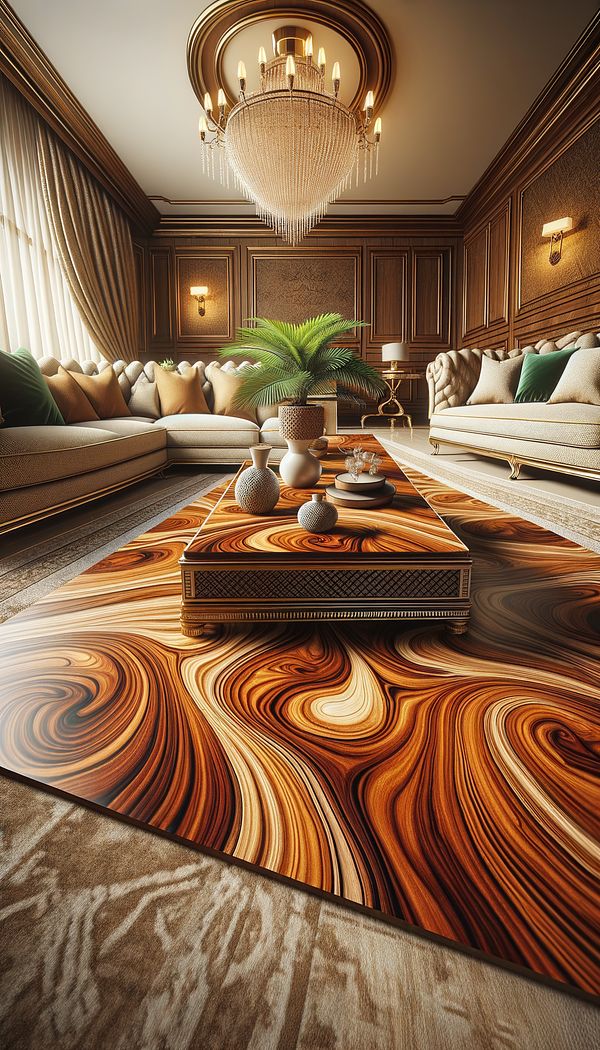What is Veneer?
Veneer is a thin layer of wood or other material applied over a base surface.
Description
Veneer, in the realm of interior design and furniture manufacturing, refers to a thin layer of real wood or other materials that is applied to the surface of less expensive materials such as plywood, particleboard, or MDF (Medium-Density Fiberboard). The practice of veneering allows for the appearance of fine wood grains and exotic materials without the high cost and weight associated with solid wood pieces. Moreover, veneers can also be applied to metal, stone, or other substrates for decorative purposes.
Veneers are cherished for their ability to showcase beautiful, rare, or endangered wood species without the environmental impact of using solid wood. The veneer process involves slicing or peeling the fine wood layer from a log and then bonding it to the base material. This technique enhances the stability of the final product by resisting warping and cracking, which can be common in solid wood due to changes in humidity and temperature. Additionally, veneers can be laid out in unique patterns such as book-matching or marquetry, adding a level of artistry and customization not easily achievable with solid materials.
Usage
Veneer is commonly used in high-end furniture making, especially in pieces like tabletops, cabinet doors, and wall panels. It's also widely utilized in the construction of musical instruments and in architectural elements where the beauty of wood is desired without the bulk and expense of solid wood. In interior design, veneer is often applied in spaces that aim for a luxurious look, such as in corporate offices, luxury homes, and boutique hotels.
FAQs
-
Can veneer be refinished?
Yes, veneer can be sanded down and refinished, but it requires a delicate touch due to its thinness. Not all veneers are thick enough to withstand deep sanding, so it's essential to proceed with caution.
-
Is veneer less durable than solid wood?
While veneers are attached to stable substrates and are generally durable, they are more prone to chipping and cannot handle the same level of wear and repair as solid wood.
-
How are veneers attached to the base material?
Veneers are typically bonded to the base material using strong adhesives. The process may involve applying pressure and heat to ensure a secure and flat connection.
-
Is veneer more affordable than solid wood?
Yes, using veneer instead of solid wood can significantly reduce costs, both in terms of material expenses and shipping or handling due to its lighter weight.
-
Can veneer be used in eco-friendly designs?
Absolutely. Veneer allows the use of rare or exotic woods without overharvesting, making it a more sustainable option when obtained from responsibly managed forests.
-
Are there different types of veneer?
Yes, there are several types of veneer, including raw veneer (without any backing), paper-backed veneer, phenolic backed veneer, and wood-on-wood veneer, each with its own applications and advantages.
Practical Application
When opting for veneer in your design projects, consider the type of veneer and its thickness according to the application. For surfaces that will endure higher traffic or usage, look for a more durable base material and a thicker veneer layer. Always source veneer from reputable suppliers to ensure quality and sustainability practices. Veneers offer a versatile and cost-effective way to bring the beauty of natural materials into your designs, whether through furniture, architectural elements, or decorative objects. Be mindful of the environmental and aesthetic implications of your choices and explore the potential for creative arrangements and finishes.
-
Architectural Elements199 articles
-
Design Styles478 articles
-
Materials & Textiles360 articles
-
Furniture Types599 articles
-
Fabrication & Craftsmanship133 articles
-
HierarchyHierarchy in interior design refers to the deliberate organization of elements in a space to signify their importance.
-
High ReliefHigh relief is a sculptural technique where the sculpted elements stand out significantly from the background.
-
VaseA vase is a container, traditionally made of glass or ceramic, used primarily for holding cut flowers or as a decorative piece.
-
Antique FinishAn antique finish refers to a surface treatment that gives an item the appearance of age and wear.
-
Ladder-BackLadder-back refers to a chair design featuring horizontal slats between two vertical posts, resembling a ladder.
